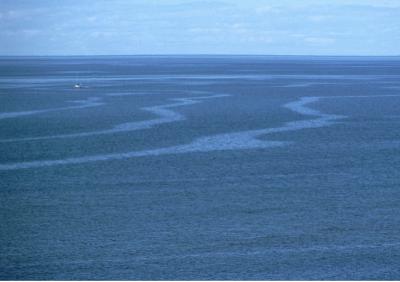Biomacromolecules’ Role in Controlling the Ocean Sea Reflectivity
Satellite altimeters map ocean surface heights by measuring the return signal. Altimeter data have observed unusually high values of the return signal, a situation termed Sigma-0 bloom. Sigma-0 blooms are known to occur due to the high reflectivity at the smooth sea surface, usually in the presence of surface slicks (conditions where capillary waves are suppressed) and at low wind conditions. However, no previous studies have shown an explicit relationship between surface slicks and Sigma-0 bloom presence. We provide a quantitative and qualitative biogeochemical explanation for the origin of the surface slicks and how surfactant concentration could work with wind speed in determining capillary wave heights. Our results suggest that biologically active oceanic regions dampen capillary waves and increase the reflectivity of the oceanic surface.
Our findings show the significant impact of the biological surfactant on surface roughness and the importance and the necessity of considering the physical activity at the sea surface when interpreting altimetric radar signals and developing ocean hydrology models. This is the first time that a biogeochemical explanation has been proposed for the origin of Sigma-0 bloom. In addition, our simplified model provides a method to identify potential Sigma-0 bloom regions throughout the world’s oceans.
Ocean altimetric data carry an error due to the Sigma-0 bloom phenomenon. Sigma-0 blooms (high backscattering values) occur when the ocean surface is smooth and absent of capillary waves, usually in surface slicks and at low wind conditions. However, a valid qualitative or quantitative explanation for the blooms that connect the extent of surface slicking and wind speed to the capillary wave height and, thereby, to the sea-air interface's reflectivity has yet to be provided. Here, a biogeochemical approach was used to explain the origin of the surface slicks and how surfactant concentration could work with wind speed in determining capillary wave heights. Using a biogeochemical model containing a set of set bio-geo-chemical equations, we demonstrate that regions of high biological activity with low wind speed in the North Atlantic will have capillary waves damped to heights less than typical radar altimeter wavelengths, resulting in a smooth sea-air interface with high radar backscattering values. Our results suggest that the highly reflective ocean surface fraction tends to increase as capillary wave amplitude decreases. The increase in Sigma-0 frequency with the reduction in capillary wave heights de- pends on both the concentration of surfactant macromolecules and wind speed. Consideration of this biological activity is critical when interpreting radar return signals from satellite altimeters used to map sea surface topography.

